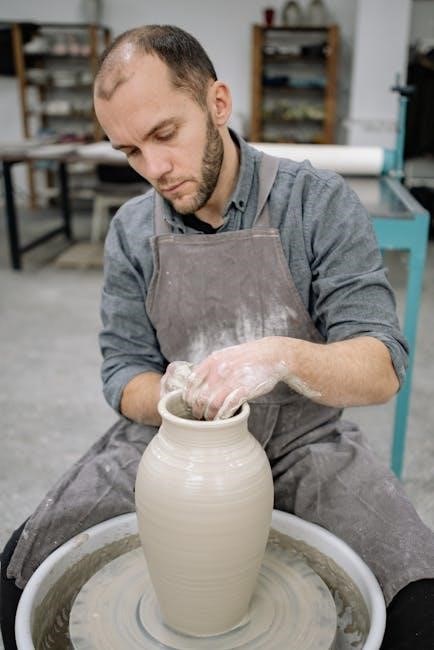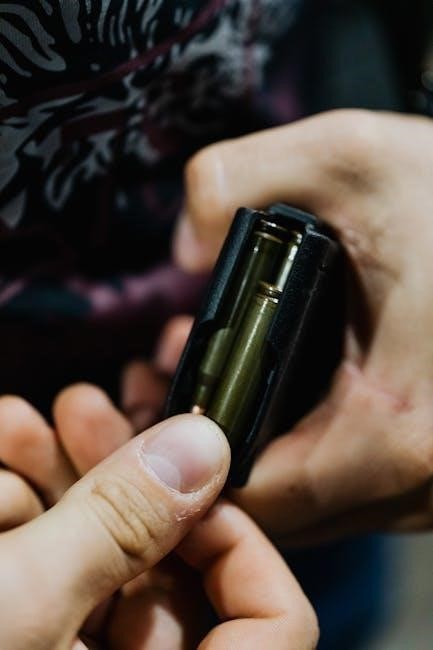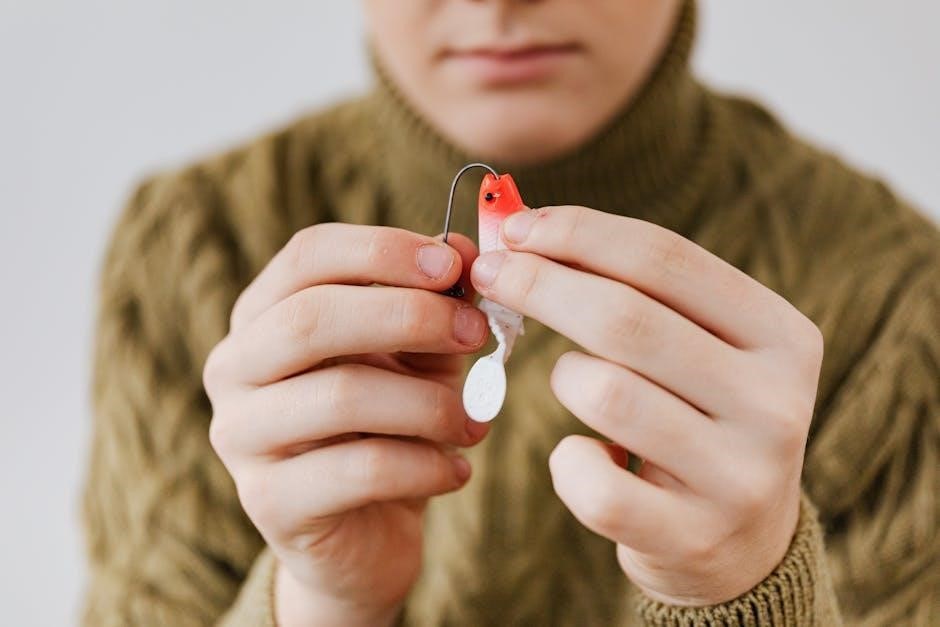The Minnesota Manual Dexterity Test (MMDT) is a standardized performance-based evaluation designed to measure simple‚ rapid hand-eye coordination and gross motor skills. It assesses unilateral and bilateral dexterity‚ focusing on eye-hand-finger movement speed and accuracy. Widely used in clinical‚ therapeutic‚ and occupational settings‚ the test is particularly applicable for evaluating motor proficiency in various populations‚ including children and adults. Its simplicity and effectiveness make it a valuable tool for rehabilitation and vocational assessments‚ providing insights into an individual’s manual dexterity capabilities.
Overview of the Test
The Minnesota Manual Dexterity Test (MMDT) is a standardized assessment tool designed to evaluate hand-eye coordination‚ fine motor skills‚ and dexterity. It measures the ability to perform rapid‚ precise movements‚ emphasizing unilateral and bilateral dexterity. The test is widely used in clinical‚ therapeutic‚ and occupational settings to assess motor proficiency in individuals‚ providing valuable insights into their manual dexterity capabilities for rehabilitation‚ vocational‚ and research purposes.
Importance of Manual Dexterity Assessment
Manual dexterity assessment is crucial for evaluating motor skills and identifying impairments. It guides rehabilitation efforts and helps predict job performance in roles requiring precision. The MMDT’s focus on rapid‚ precise movements makes it invaluable for clinical and occupational settings‚ aiding in personalized treatment plans and vocational assessments.

History and Development of the Minnesota Manual Dexterity Test
The Minnesota Manual Dexterity Test was developed to evaluate hand-eye coordination and motor skills. Its origins trace back to studies focusing on manual proficiency and dexterity assessments.
Creators and Initial Purpose
The Minnesota Manual Dexterity Test was created by researchers at the University of Minnesota to assess manual dexterity and motor skills; Initially designed to evaluate hand-eye coordination for industrial and occupational purposes‚ the test aimed to measure an individual’s ability to perform precise tasks quickly and accurately. Its development was influenced by the need for standardized tools in vocational and therapeutic assessments.
Evolution Over Time
The Minnesota Manual Dexterity Test has evolved since its inception‚ adapting to new research and clinical needs. Originally developed for occupational assessments‚ it has expanded to include norms for various age groups and populations. Recent studies have explored its sensitivity to factors like hand stretching and the integration of digital tools for precise scoring. These advancements ensure its relevance in modern clinical and therapeutic settings.

Components of the Minnesota Manual Dexterity Test
The test features a standardized setup with a board and small objects‚ requiring precise placement tasks. It includes a battery of subtests to evaluate unilateral and bilateral dexterity effectively.
Test Setup and Materials
The Minnesota Manual Dexterity Test utilizes a specially designed board with holes and small objects‚ such as pins or pegs. The setup includes a flat surface where participants place the objects‚ requiring precise hand movements. The materials are standardized to ensure consistency across administrations‚ making the test reliable for assessing motor skills and dexterity.
Test Battery and Subtests
The Minnesota Manual Dexterity Test comprises a battery of subtests designed to evaluate different aspects of motor proficiency. These include tasks that require placing pins into holes‚ turning screws‚ and other fine motor activities. Each subtest is timed to assess speed and accuracy‚ providing a comprehensive measure of hand-eye coordination and dexterity.
Administration and Scoring
The MMDT is administered under standardized conditions‚ with tasks requiring rapid completion. Scoring is based on time taken to finish each subtest‚ ensuring objective assessment of dexterity.
Test Instructions and Setup
The Minnesota Manual Dexterity Test requires specific setup‚ including a pegboard with holes and disks. Participants are instructed to pick up and place disks into holes using one hand. The administrator demonstrates the task‚ emphasizing speed and accuracy. The test begins when the participant starts‚ and completion time is recorded. Clear instructions ensure consistency across administrations.
Scoring Criteria and Interpretation
The Minnesota Manual Dexterity Test is scored based on the time taken to complete tasks‚ with faster times indicating better dexterity. The test-retest reliability is high‚ with intraclass correlation coefficients ranging from 0.79 to 0.87. Interpretation focuses on assessing eye-hand coordination and motor proficiency‚ providing insights into an individual’s ability to perform rapid‚ precise movements. The results are useful for clinical and occupational evaluations‚ helping to identify motor skill deficits or improvements over time.

Reliability and Validity of the Test
The Minnesota Manual Dexterity Test demonstrates strong test-retest reliability‚ ensuring consistent results. Its validity in assessing hand-eye coordination and motor skills is well-established‚ making it a reliable tool for clinical and occupational evaluations.
Test-Retest Reliability
The Minnesota Manual Dexterity Test exhibits strong test-retest reliability‚ with intraclass correlation coefficients ranging from 0.79 to 0.87. This indicates consistent and reliable results across repeated administrations‚ ensuring the test’s accuracy in measuring hand-eye coordination and motor skills. Its reliability makes it a dependable tool for both clinical assessments and occupational evaluations‚ providing consistent data for decision-making.
Validity in Assessing Dexterity
The Minnesota Manual Dexterity Test demonstrates strong validity in assessing dexterity‚ effectively measuring eye-hand coordination‚ finger movement‚ and gross motor skills. Studies confirm its ability to evaluate motor proficiency accurately‚ with applications in clinical and occupational settings. The test’s validity is supported by its consistent performance in predicting task-specific dexterity and its widespread use in rehabilitation and vocational assessments. Its focus on rapid‚ precise movements ensures reliable dexterity evaluation across diverse populations.

Applications and Uses of the MMDT
The Minnesota Manual Dexterity Test is widely used in clinical‚ therapeutic‚ and occupational settings to assess motor skills. It aids in rehabilitation‚ physical therapy‚ and vocational assessments‚ helping evaluate individuals’ dexterity for specific jobs or therapies. Its versatility makes it effective for children and adults‚ providing valuable insights into manual proficiency for various applications.
Clinical and Therapeutic Applications
The Minnesota Manual Dexterity Test is extensively utilized in clinical settings to assess and monitor progress in patients with motor impairments. It is particularly effective in rehabilitation programs for individuals recovering from injuries or surgeries. Therapists use the test to design targeted exercises‚ improving hand-eye coordination and fine motor skills. Its objective measurements help track recovery milestones‚ ensuring personalized and effective treatment plans for patients.
Occupational and Industrial Uses
The Minnesota Manual Dexterity Test is widely applied in occupational settings to evaluate candidates for jobs requiring precise hand movements. It serves as a valuable tool for employee selection‚ particularly in roles involving rapid manipulation tasks. The test helps assess an individual’s suitability for positions in industries like manufacturing and assembly‚ ensuring workplace safety and efficiency by identifying those with adequate dexterity for specific tasks.
Normative Data and Performance Standards
The Minnesota Manual Dexterity Test provides normative data for individuals aged 7 to 18‚ offering age-related performance standards. It is adaptable for diverse populations‚ ensuring fair assessment across different demographic groups.
Age-Related Norms
The Minnesota Manual Dexterity Test provides established norms for individuals aged 7 to 18‚ with specific benchmarks for unilateral and bimanual dexterity. These age-related standards allow for accurate comparisons of motor skills development across different age groups. The test’s reliability‚ with intraclass correlation coefficients of 0.79 to 0.87‚ ensures consistent and valid assessments‚ making it a reliable tool for evaluating dexterity in children and adolescents.
Gender and Population-Specific Standards
The Minnesota Manual Dexterity Test incorporates norms for different genders and populations‚ ensuring fair assessment across diverse groups. While primarily standardized for ages 7 to 18‚ the test is adaptable for various clinical populations. Its reliability‚ with coefficients ranging from 0.79 to 0.87‚ supports consistent evaluation across gender and population-specific standards‚ enhancing its applicability in both clinical and occupational settings.

Bilateral vs. Unilateral Dexterity
The Minnesota Manual Dexterity Test evaluates both bilateral and unilateral dexterity‚ assessing speed and accuracy in performing tasks with one or both hands‚ reflecting motor skill complexity.
Assessment of Bilateral Dexterity
The Minnesota Manual Dexterity Test includes tasks requiring coordination between both hands‚ such as placing small objects in specific patterns. This subtest evaluates the ability to perform complex motor tasks simultaneously with both hands‚ measuring speed and accuracy. Bilateral dexterity assessment is crucial for understanding an individual’s capacity for tasks requiring two-handed coordination‚ which is essential in many vocational and daily living activities. The test provides insights into how effectively both hands work together to achieve precise movements.
Focus on Unilateral Dexterity
The Minnesota Manual Dexterity Test emphasizes unilateral dexterity through tasks requiring precision and speed with one hand. Participants perform actions like placing small objects in specific patterns‚ evaluating individual hand functionality. This subtest is crucial for assessing fine motor skills and hand dominance‚ providing insights into an individual’s ability to execute tasks requiring single-handed dexterity‚ which is vital for many occupational and daily activities.

Age Range and Adaptations
The Minnesota Manual Dexterity Test is suitable for various age groups‚ including children aged 7-18‚ and is adapted for clinical and therapeutic populations‚ ensuring versatility.
Appropriateness for Children
The Minnesota Manual Dexterity Test is suitable for children aged 7 to 18‚ making it a valuable tool for pediatric assessments. Its design allows for objective measurement of unilateral and bilateral dexterity in younger populations. The test’s simplicity and standardized administration ensure reliability‚ providing clinicians with insights into motor skill development. This makes it particularly useful for early identification of motor delays and planning targeted interventions.
Adaptations for Different Populations
The Minnesota Manual Dexterity Test can be adapted for diverse populations‚ including those with physical limitations or cultural differences. Modifications‚ such as adjusted test setups or timing‚ ensure accessibility while maintaining reliability. These adaptations enable clinicians to assess dexterity in various groups‚ from children to adults‚ with specific needs. Such flexibility makes the test inclusive and effective across different demographic and ability levels.

Comparison with Other Dexterity Tests
The Minnesota Manual Dexterity Test stands out for its focus on eye-hand coordination and gross motor skills‚ differing from tests like the Nine-Hole Peg Test‚ which emphasizes finger dexterity. Its standardized approach ensures reliability‚ making it a preferred choice for assessing manual dexterity in various clinical and occupational settings compared to other tools.
Similar Assessments
Other dexterity tests‚ like the Nine-Hole Peg Test and the O’Connor Finger Dexterity Test‚ share similarities with the MMDT in measuring hand-eye coordination and fine motor skills. These assessments also evaluate manual proficiency‚ focusing on speed and accuracy‚ though they differ in specific tasks and populations. The MMDT‚ however‚ stands out for its emphasis on both unilateral and bilateral dexterity‚ making it versatile for various clinical and occupational evaluations.
Unique Features of the MMDT
The MMDT uniquely combines assessments of both unilateral and bilateral dexterity‚ providing a comprehensive evaluation of motor skills. Its test battery includes multiple subtests‚ ensuring a detailed analysis of hand-eye coordination and gross motor abilities. Unlike other tests‚ the MMDT’s design allows for adaptability across different age groups and populations‚ making it a versatile tool in both clinical and occupational settings for measuring manual dexterity effectively.

Recent Studies and Research Findings
Recent studies highlight the MMDT’s effectiveness in assessing motor skills‚ with findings showing improved test completion times after static hand stretching‚ enhancing dexterity measurement accuracy.
Current Applications in Research
The Minnesota Manual Dexterity Test is widely used in clinical and research settings to assess motor function‚ particularly in studies examining hand-eye coordination and fine motor skills. Recent research has utilized the MMDT to evaluate the impact of static stretching on dexterity‚ demonstrating reduced completion times without compromising accuracy. Additionally‚ the test is employed in studies focusing on rehabilitation outcomes‚ occupational performance‚ and the effects of neurological conditions on motor abilities‚ providing valuable insights into human motor function and recovery processes.
Emerging Trends and Discoveries
Recent studies highlight the integration of advanced technologies‚ such as biomechanical motion capture‚ to enhance the accuracy of dexterity assessments. Research also explores the impact of static stretching on test performance‚ showing improved completion times without compromising accuracy. Additionally‚ automated systems are being developed to track specific time metrics‚ offering deeper insights into motor function and dexterity. These advancements underscore the evolving nature of the MMDT in modern research settings.

Clinical Significance and Practical Implications
The MMDT significantly impacts clinical rehabilitation by assessing motor skills and dexterity‚ guiding therapeutic interventions‚ and improving treatment outcomes in occupational therapy settings.
Diagnostic Value
The MMDT holds strong diagnostic value in identifying motor skill impairments‚ enabling early detection of dexterity issues. Its standardized approach ensures reliable results‚ aiding in the formulation of targeted rehabilitation plans. The test’s ability to measure both unilateral and bilateral dexterity provides comprehensive insights into motor function‚ making it an essential tool for clinicians in assessing and monitoring progress in motor recovery;
Impact on Rehabilitation Practices
The Minnesota Manual Dexterity Test significantly influences rehabilitation practices by providing actionable insights into motor skill recovery. It enables clinicians to design personalized therapy plans‚ track progress‚ and set realistic goals. The test’s focus on unilateral and bilateral dexterity helps identify specific areas for improvement‚ facilitating targeted interventions. This tool is instrumental in guiding rehabilitation strategies‚ ensuring effective restoration of motor function and enhancing patient outcomes.
The Minnesota Manual Dexterity Test remains a vital tool for assessing motor skills‚ offering insights into rehabilitation‚ occupational‚ and clinical practices. Its versatility ensures continued relevance.
The Minnesota Manual Dexterity Test (MMDT) is a standardized tool for assessing hand-eye coordination and gross motor skills. It evaluates unilateral and bilateral dexterity‚ focusing on speed and accuracy. Widely used in clinical‚ therapeutic‚ and occupational settings‚ the test is effective for both children and adults. Its reliability and versatility make it a valuable resource for rehabilitation and vocational assessments‚ providing clear insights into manual dexterity capabilities.
Future Directions for the MMDT
Technological advancements may enhance the MMDT’s administration and scoring‚ potentially through digital platforms. Future directions include expanded validation across diverse populations‚ integration with other motor skill assessments‚ and exploring applications in emerging fields. Research may focus on its role in occupational therapy and rehabilitation‚ while standardization efforts continue to ensure reliability and global accessibility.
